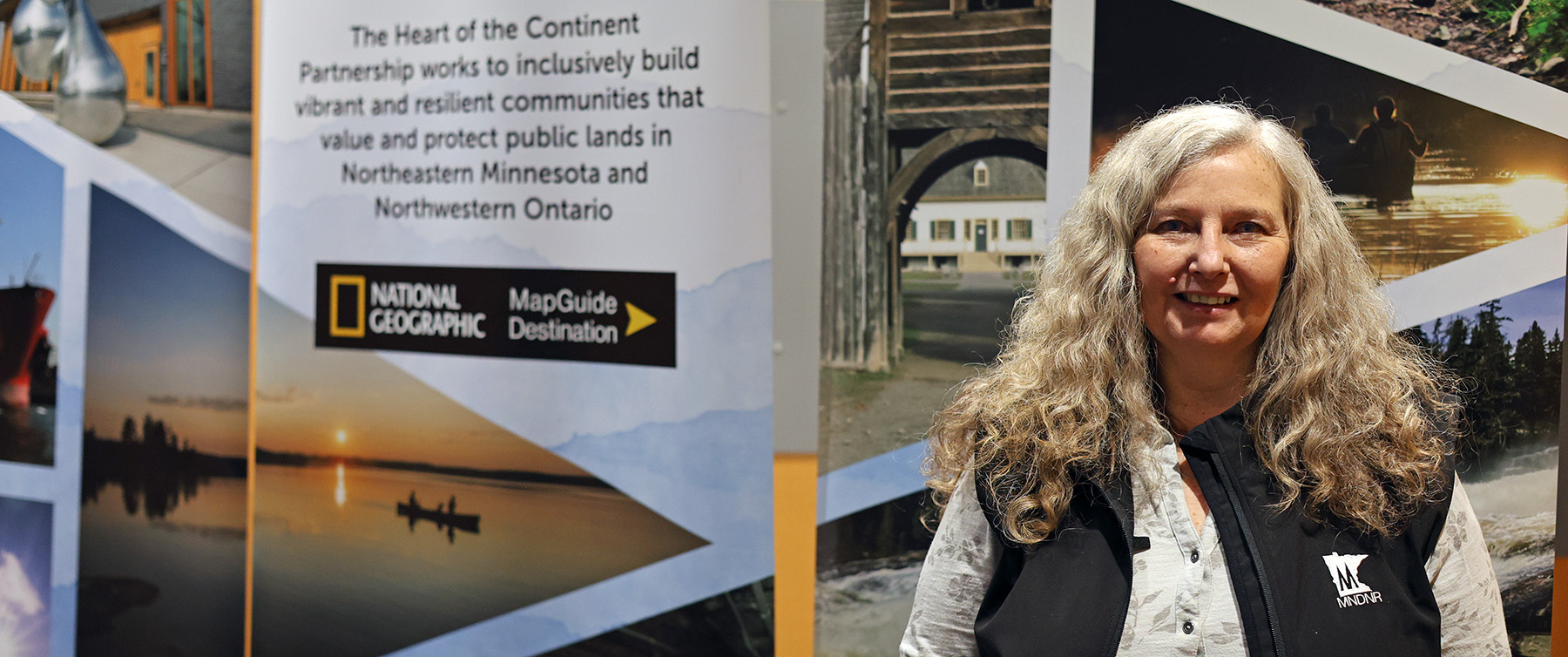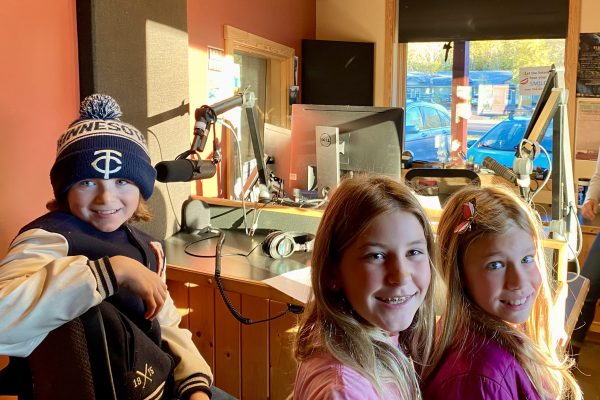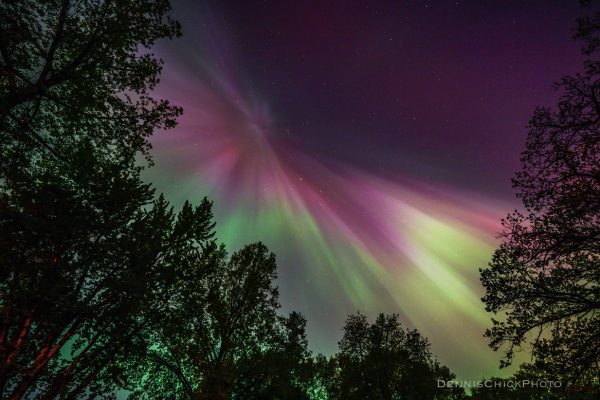Jay Cooke State Park collaborates with Fond du Lac on dual-language signs
The Heart of the Continent Partnership Winter Gathering was held at Grand Portage Lodge and Casino on February 20-21, 2024. The event featured public land managers and a variety of speakers from the U.S., Canada, and tribal nations covering topics that relate to public lands and the people who visit and live on those lands. Presentations covered a range of topics including different management approaches to moose habitat, wildland fires, and dark sky preservation across political and cultural boundaries.
WTIP’s Chuck Olsen spoke by phone with Lisa Angelos, park manager at Jay Cooke State Park about her presentation which is titled: Jay Cooke Park Signage Project – Building Trust with the Fond du Lac Band of Superior Chippewa.
The interview transcript and audio are below.
CHUCK OLSEN
Lisa, what brought you to the Heart of the Continent’s winter gathering?
LISA ANGELOS
Yeah, I came to the Heart of the Continent to discuss a signage project that we did at Jay Cooke State Park. It was a multilingual project between Jay Cooke and the Fond du Lac Band of Lake Superior Chippewa, and to share some things I learned about collaborations in that setting.
CHUCK OLSEN
Right, you mentioned in your presentation how you started out with an idea of wanting to include Ojibwemowin language to educate people about the names of river animals, and then you sort of talked about how that opened up a broader cultural conversation and learning how to collaborate with them on even what the project was. Do you want to talk a little bit about what your starting point was and then how that changed?
LISA ANGELOS
Sure, yeah. For sure, we originally had in mind perhaps a project just introducing people to the river animals that live in the park and what their names would be in Ojibwe, and after having some of the initial conversations just about, hey, this is an idea, you know, we definitely weren’t set in stone on what the project would be. It was becoming clear that there was just so much rich information and things that our visitors would be interested in hearing and that would benefit the tribal community as well to share information that we should expand the scope of the project.
And so one of my tips about collaboration is, you know, really embrace the idea of true collaboration and don’t come with a final set of what you’re going to do. Allow the conversations to kind of plan that together and affect the scope. So in the end, we have a project that has an aspect of those river animals, but they’re incorporated into a much more comprehensive foresign project that addresses Ojibwe language as well as many other cultural concepts.
CHUCK OLSEN
Yeah, I think one of your slides shows the relationship between water and life and broad concepts from Fond du Lac culture. And in addition to having, I see one of the signs here has “Learn Ojibwemowin,” and it has the Ojibwe word for fish, and then how to pronounce it, wild rice, manoomin, and things like that. So it’s just interesting to me to hear about how language is like the doorway to culture.
And it looks like you really embraced that idea of talking more about the culture and not just a couple of words.
LISA ANGELOS
Yeah, it was really our pleasure to have the opportunity to have those deeper discussions. And some of the other points that we learned along the way is, you know, there’s a trust that has to be developed. And sometimes that goes beyond just that relationship in the moment.
And it’s connected to a lot of the history that has gone before. And so understanding that there’s a trust timescale that might be a little bit longer than you thought it would be. And to just not let that deter you and just continue on with the with the course of what you’re doing, and your intention hopefully will be welcomed and understood.
And that leads to another tip that we learned, which was, make sure that you have enough time, sufficient time for the project, including building in some time for incorporating changes. We did have some changes in the project that were introduced along the way when project team members changed after COVID-19. And so that added another dimension to time.
But we wanted to communicate respectfully and demonstrate shared values. And so we wanted to move ahead in a way that the people that we were working with in the end were happy with the project.
CHUCK OLSEN
Yeah, absolutely. Do you have a way to accommodate for staffing changes, on your end of that, that help preserve what you’ve built?
LISA ANGELOS
Well, I do think that just talking about it with one another and sharing these types of messages across the spectrum of people working to try to build relationships across cross-cultural networks is a great way to, build that into the system so that it isn’t as dependent on an individual. I think grassroots efforts are critical. So individuals matter.
But I think, you know, speaking up as individuals when you have progress and success and or difficulties, and how you work through those, helps build that into the ongoing ability of an organization to respond more appropriately and learn from the past and their experiences to not make it as tenuously connected to one individual.
CHUCK OLSEN
Yeah, so it’s a more of a kind of shared and distributed and not just reliant on one person. Is there anything that you wanted to speak to as far as, this project was meant to help address how endangered the Ojibwe language is?
LISA ANGELOS
Yeah, it was meant to offer up an opportunity to take one small step to contribute to the efforts to revitalize the language. Because it is so rare, and so much has been lost, that an opportunity for the park to highlight the language and give people, be they Fond du Lac band members who live right nearby, or visitors who are just interested, an opportunity to see and learn the language of some of the people that were living in the area long before the park was there, was a piece that we could do, a responsibility that we took pretty seriously to provide a small platform for that. And I mentioned some changes about the project that had occurred along the way, and some of that had to do with what aspects of the language were being used, and what words should be chosen to best represent the concept. Because when you’re dealing with the endangered language, there’s the words, but there’s also the way that the words are expressed and put together to most relate culturally and make it meaningful.
So an example is, at one point we were trying to figure out the best way to say part of a watershed, a little piece of a greater hole, that concept was discussed to pick out the best way to do that. Because it’s like, yes, the watershed is the bigger entity, but that’s still connected to something bigger yet. And so ultimately, the words that were chosen for that, that ended up on the final version, are the Ojibwe words for “One that is related in a certain way.”
So that connects back to those cultural concepts of, everything is connected. And I think that kind of demonstrates how critical language is to cultural ways. Because how you choose to say something is who you are.
That’s why it was such a privilege to work on this.
CHUCK OLSEN
Yeah, it represents deep relationships. And it’s worth taking the time to consider that thoughtfully and get it right. So I thank you for embarking on that.
And we did talk about, I’m hoping to chat with someone from the Fond du Lac Band, which the best opportunity might be at the unveiling for the signs. I know that’s not nailed down yet. Is there maybe a general season that we should anticipate when the signs might be publicly unveiled?
LISA ANGELOS
Yes. So we’re hoping that it’s going to be prior to summer. So I would say spring of 2024, we don’t have the exact date determined yet.
We had an error that had to be reprinted on one piece of the sign. But all of the structures in which the signs will be mounted are already in place. And we’re basically just waiting for coordination with the band as to what would be a good date.
And we’ll get it out there because we’re interested in appropriately celebrating with them at a time that works well. But we’re definitely committed to having it up before the main season of 2024. And having that opportunity to focus not just on historical aspects of tribal relationships, but also current situations today with the people that are living right next door that helped contribute to this project and be a good opportunity for visitors to come out and see the signs and celebrate together.
CHUCK OLSEN
I’ll be there. It sounds great.
And just one more question. Have you been able to share this more broadly with other state parks and the DNR? And is this something that helps set an example for perhaps similar projects that could happen within the 1854 ceded territory?
LISA ANGELOS
Yes, we do, as I mentioned, share the work that we do with one another. This was a very in-depth project that we spent a lot of time on. But in no means is it the only state park project focused around incorporation of values that are important to tribal partners.
A few other examples are some of our hiking club trail passwords are in Indigenous languages. We do have some names of structures in, say, for example, Lake Vermilion State Park. I know they have names of some of their facilities that are in Indigenous language.
And as I mentioned, at the Heart of the Continent gathering, there are a multitude of ways that Minnesota State Parks do work with our tribal partners, be it for environmental review processes or offering a platform for their information and presentations, inviting them to come to events, providing opportunities for students. So Minnesota State Parks is quite engaged with the tribal partners, but we always do have more to do and more to learn. And whenever you’re doing some work, we’ve got to acknowledge that we’re working with just some individuals. And that doesn’t mean that it’s the perspective of every Native person. It’s just one effort in a big picture. And we all have a much bigger story to tell with many versions.
And we are committed in Minnesota State Parks to do our best to work toward those goals.
CHUCK OLSEN
Wonderful. Well, Lisa, thank you for telling the broader story of the land that Jay Cooke State Park is on and sharing that with your neighbors at Fond du Lac. And yeah, we’ll look forward to the unveiling of those this spring.
LISA ANGELOS
Yes, thank you. And we will be making it known on our event calendar when that is going to take place. So we’ll make sure that it’s not a secret and people can come out and enjoy the signs.
And then hopefully they’ll be there for a very long time. In a prominent location, they’ll be located between our main headquarters and the river and Interpretive Center, quite prominently placed in the park. So it’ll be easy to see.
CHUCK OLSEN
Awesome. It shant be kept a secret. Thanks, Lisa.















